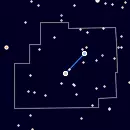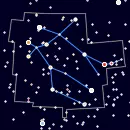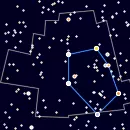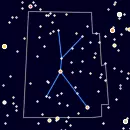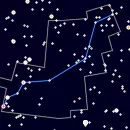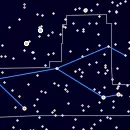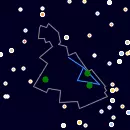Winter Constellations: Explore the Star Patterns of the Season
Sky Map
Celectial bearing and elevation at 23:15
As the Earth orbits the Sun, different constellations come into view depending on the season and your location on the planet. For observers in the Northern Hemisphere, winter may bring the bright stars of Orion and Taurus, while those in the Southern Hemisphere might see different celestial patterns, like the Southern Cross, dominating their night skies. The constellations you can see also shift as the year progresses—spring, summer, and autumn each bring their own set of star patterns, visible from one hemisphere or another. Use our seasonal guides to discover what’s visible from your location, and learn about the key stars and constellations that light up the sky during each season.
Canis Minor
Constellation
Canis Minor, the lesser dog, is a small constellation in the northern sky, containing the bright star Procyon, part of the Winter Triangle asterism.
Gemini
Constellation
Gemini, the twins, is a zodiac constellation representing the mythological twins Castor and Pollux. It is known for its bright stars, Castor and Pollux, and its prominent place in the winter sky.
Auriga
Constellation
Auriga, the charioteer, is a constellation in the northern sky with the bright star Capella, one of the brightest stars visible from Earth.
Cancer
Constellation
Cancer, the crab, is a small constellation in the zodiac, known for its dim stars and the open cluster Praesepe, or the Beehive Cluster.
Lynx
Constellation
Lynx, the lynx, is a faint northern constellation. Its name refers to the animal known for its sharp sight, symbolizing the challenge of finding its dim stars.
Monoceros
Constellation
Monoceros, the unicorn, is a faint constellation located near Orion, known for containing several star clusters and nebulae.
Camelopardalis
Constellation
Camelopardalis, the giraffe, is a large but faint constellation in the northern sky, representing a giraffe or a camel.
Acknowledgements
We gratefully acknowledge the International Astronomical Union (IAU) for defining and standardizing the official constellation boundaries, which provide a consistent framework for celestial mapping.
Special thanks to Sky & Telescope Magazine and contributors Roger Sinnott and Rick Fienberg for their collaboration in producing the charts and tables. The constellation patterns, drawn by Alan MacRobert, were influenced by the work of H. A. Rey and thoughtfully adjusted to align with earlier traditions.

